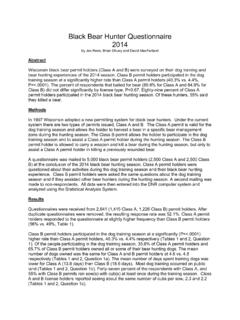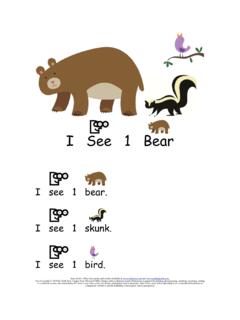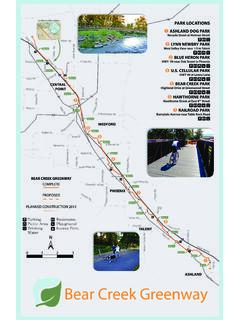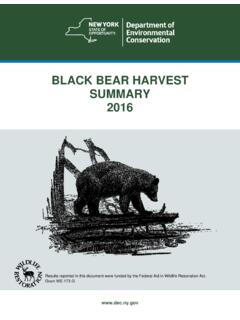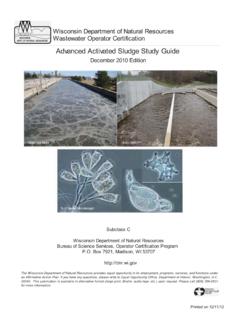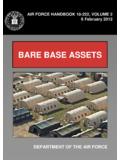Transcription of Status, management and distribution of large carnivores ...
1 status , management and distribution of large carnivores bear , lynx, wolf & wolverine in Europe DECEMBER 2012 - Part 1- status of large carnivores in Europe update 2012 2 This document has been prepared with the assistance of Istituto di Ecologia Applicata and with the contributions of the IUCN/SSC large carnivore Initiative for Europe (chair: Luigi Boitani) under contract N 070307/2012/629085/SER/B3. status , management and distribution of large carnivores bear , lynx, wolf & wolverine in Europe Petra Kaczensky1, Guillaume Chapron2, Manuela von Arx3, Djuro Huber4, Henrik Andr n2, and John Linnell5 (Editors) 1 Research Institute of Wildlife Ecology, University of Veterinary Medicine, Vienna, Savoyenstrasse 1, A - 1160 Vienna, AUSTRIA 2 Grims Wildlife Research Station, Department of Ecology, Swedish University of Agricultural Sciences (SLU), SE - 73091 Riddarhyttan, SWEDEN 3 Coordinated Research Projects for the Conservation& management of carnivores in Switzerland (KORA)
2 , Thunstrasse 31, CH-3074 Muri, SWITZERLAND 4 University of Zagreb, Biology Department, Veterinary Faculty, Heinzelova 55, HR - 10000 Zagreb, CROATIA 5 Norwegian Institute for Nature Research (NINA), Tungasletta 2, NO-7047 Trondheim, NORWAY Contributors (in alphabetical order): Michal Adamec, Francisco lvares, Ole Anders, Henrik Andr n, Linas Balciauskas, Vaidas Balys, Peter Bedo, Ferdinand Bego, Juan Carlos Blanco, Luigi Boitani, Urs Breitenmoser, Henrik Br seth, Ludek Bufka, Raimonda Bunikyte, Guillaume Chapron, Paulo Ciucci, Alexander Dutsov, Thomas Engleder, Christian Fuxj ger, Claudio Groff, Mikl s Heltai, Katja Holmala, Bledi Hoxha, Djuro Huber, Yorgos Iliopoulos, Ovidio Ionescu, Gjorge Ivanov, Jasna Jeremi , Klemen Jerina, Petra Kaczensky, Ilpo Kojola, Ivan Kos, Miha Krofel, Jakub Kubala, Sasa Kunovac, Josip Kusak, MiroslavKutal, John Linnell, Peep Mannil, Ralph Manz, Eric Marboutin, Francesca Marucco.
3 Dimce Melovski, Kujtim Mersini, Yorgos Mertzanis, Robert W. Mys ajek, Sabina Nowak, John Odden, Janis Ozolins, Guillermo Palomero, Milan Paunovic, Jens Persson, Hubert Poto nik, Pierre-Yves Quenette, Georg Rauer, Ilka Reinhardt, Robin Rigg, Andreas Ryser, Valeria Salvatori, Toma Skrbin ek, Aleksandra Skrbin ek-Maji , Aleksandar Stojanov, Jon Swenson, Aleksand r Traj e, Elena Tzingarska-Sedefcheva, Martin V a, RaunoVeeroja, Manuela von Arx, Manfred W lfl, Sybille W lfl, Fridolin Zimmermann, Diana Zlatanova This document has been prepared for the European Commission however it reflects the views only of the authors, and the Commission cannot be held responsible for any use which may be made of the information contained therein.
4 Reproduction is authorised provided the source is acknowledged Cover: Photo composition by Alessandro Montemaggiori status of large carnivores in Europe update 2012 3 Table of contents Part 1: I. General Introduction 4 II. Methods 5 III. Europe summaries 15 1. bear 16 2. Lynx 28 3. Wolf 40 4. Wolverine 54 IV. Appendix 60 1. large carnivore Populations in Europe. 61 2. Some examples of the diversity of data formats that were provided for the mapping large carnivore distribution in Europe. 62 3. Questionnaire on the status and management of large carnivores in Europe. 66 status of large carnivores in Europe update 2012 4 I. General introduction large carnivores (bears Ursus arctos, wolves Canis lupus, lynx Lynx lynx and wolverines Gulo gulo) are among the most challenging group of species to maintain as large and continuous populations or to reintegrate back into the European landscape.
5 Political, socioeconomic and society changes challenge past management approaches in some of the large populations. At the same time local improvements in habitat quality, the return of their prey species, public support and favourable legislation allow for the recovery of some small populations. Several of Europe s large carnivore populations are large and robust, others are expanding, some small populations remain critically endangered and a few are declining. large carnivores need very large areas and their conservation needs to be planned on very wide spatial scales that will often span many intra- and inter-national borders. Within these large scales conservation and management actions need to be coordinated.
6 To facilitate coordination, a common understanding of the present day conservation status of large carnivores at national and population level is an important basis. The aim of this summary report is to provide an expert based update of the conservation status of all populations identified by the large carnivore Initiative for Europe (LCIE), available in the document Guidelines for Population Level management Plans for large carnivores (Linnell et al. 2008) and/or in the various Species Online Information Systems ( ; also see Appendix 1). However, methods used to monitor large carnivores vary and a direct comparison over time or among populations will never be possible at a continental scale.
7 It is more realistic to have an insight into the general order of magnitude of the population, its trend and permanent range as the currencies for comparisons and assessments (see point 2). This summary also does not aim to replace the habitat directive reporting, but rather complement it. Discrepancies will likely occur due to different time periods covered and different agreements reached on common reporting criteria on a national level which has to deal with many more species. Furthermore, for several countries the most recent data or distribution map were not always available, yet. Changes in monitoring methods likely result in changing population estimates, even in stable populations.
8 Improved and more costly methods may suddenly discover that previous estimates were too high, or may detect more individuals than previously assumed. Examples of both occur. Being aware of the change in methodology the expert assessment may still be stable for the population even if numbers listed in tables have changed. On the other hand, large scale official (government) estimates may be based on questionable or non-transparent extrapolations that run contrary to data from reference areas within the country or similar regions from other countries. If the discrepancy is apparent, expert assessment needs to question official numbers. This summary does not aim at reviewing monitoring techniques.
9 Examples of parameters and principles for monitoring large carnivores and some good practice examples have been previously compiled by the LCIE ( ). Furthermore, references at the end of many country reports do provide ample examples of well documented and state of the art monitoring of large carnivores in Europe under a wide variety of different contexts. status of large carnivores in Europe update 2012 5 II. Methods 1. Collection of information European Species Summaries In order to collect standardized information on the status and management of large carnivores a questionnaire was designed and mailed to all members of the LCIE and some other key experts in 2012.
10 They were asked to either fill in the questionnaire themselves or ask colleagues to do so. The questionnaire had 8 sections focusing on (see Appendix 3): 1. Abundance 2. Range 3. management & harvest 4. Livestock depredation & compensation system 5. Threat to survival 6. Conservation measures 7. Issues of particular interest 8. Ongoing or recently terminated conservation / research project In total we received back 76 questionnaires (Table 1). Some additional material was compiled from recent reports or publications and/or by contacting national LC experts via e-mail or telephone. Based on these questionnaires we compiled a Europe wide overview of the situation of lynx, bear , wolf and wolverine in Europe trying to compile information on the level of populations outlined by Linnell et al.











